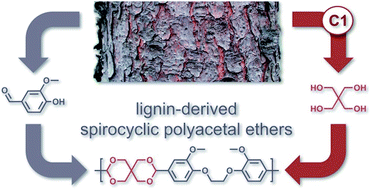Cyclic and spirocyclic polyacetal ethers from lignin-based aromatics†
Abstract
Monomers structurally resembling lignin were prepared by reacting 4-hydroxybenzaldehyde, vanillin, syringaldehyde, (each bio-available) or ethylvanillin (synthetic) with dibromoethane, yielding dialdehydes CHO–Ar–OCH2CH2O–Ar–CHO. Condensation copolymerization with tetraols catalyzed by para-toluene sulfonic acid yielded polyacetal ethers with cyclic acetals in the case of di-trimethylolpropane (di-TMP) and spirocyclic acetals in the case of pentaerythritol (PTOL). Number average molecular weights (Mn) were in the range of 10 600 to 22 200, although the insolubility of those polymers based on 4-hydroxybenzaldehyde precluded this measurement. The polymers are thermally robust and exhibit 5% mass loss via thermogravimetric analysis in the range of 307–349 °C. Those copolymers based on PTOL displayed glass transition (Tg) temperatures (108–152 °C) at least 40 °C higher than their di-TMP analogues (68–98 °C), highlighting the added rigidity conferred by spirocyclic acetals versus cyclic acetals. Preliminary degradation studies were conducted in dimethyl sulfoxide with 0.5% added aqueous HCl (concentrated or 2 M). Dynamic light scattering confirmed the facile hydrolysis of the polymers. Generally, polymer degradation was faster with a higher acid concentration and copolymers from the PTOL tetraol were more resistant to hydrolysis than those from the di-TMP tetraol.

- This article is part of the themed collection: Sustainable polymers: replacing polymers derived from fossil fuels

 Please wait while we load your content...
Please wait while we load your content...